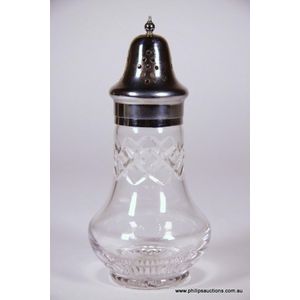Rococo-style Mustard Pot with Cupid Reserves & Glass Liner
You must be a subscriber, and be logged in to view price and dealer details.
Subscribe Now to view actual auction price for this item
When you subscribe, you have the option of setting the currency in which to display prices to $Au, $US, $NZ or Stg.
- Finial - An architectural decoration, found on the upper parts of of an object. On furniture they are usually found on pediments, canopies and shelf supports. On smaller ceramic or silver items, such as spoons, they may decorate the top of the item itself, or the lid or cover where they provide a useful handle for removal.
Finials have a variety of shapes and forms. They may be urn-shaped, baluster shaped round or spiral, but usually taper into an upper point. Many real life shapes may also be used as finials, such as pineapples, berries, pinecones, buds, lotus and acorns. Sometimes animals such as a lion are depicted, or fish and dolphins. - Hallmarks - A mark stamped on articles of precious metals in Britain, since the 14th century, certifying their purity. It derives its name from the Guild Hall of the Goldsmiths' Company, who recieved its Charter in 1327 giving it the power to assay (test the purity) and mark articles of gold and silver.
The hallmark will consist of several marks, including the:
- silver standard mark, indicating the purity of the metal. Sterling silver is .925 pure silver.
- the city mark indicating the city in which it was assayed eg London, Birmingham, York etc.
- the date mark, usually a letter of the alphabet in a particular font and case,
- a duty mark, indicating whether duty had been paid to the crown, and only in use from 1784 to 1890
The piece may include an additional mark, the maker's mark, although not forming part of the hallmark, will be located in the vicinity of the hallmarks.
Sometimes silver plated items will bear faux hallmarks, often confusing those not familiar with silver markings.
This item has been included into following indexes:
- mustard pots - silver items 212
- silver, country of manufacture
Visually similar items

A three piece silver coffee set, 19th century Germany, with marks H&Co, wholesaler mark of Henniger & Co, the coffee pot and two jugs of mallet vase form each raised on a circular foot with a finely cast laurel frieze, a festooned monogram to the body, flu

A Stuart Crystal sugar caster, of pillar form with a compressed globular lower body, diamond cut to the neck, a star burst underside and with a plated dome cover with finial. Height 16.5 cm

A Victorian silver pepperette, vase shape, half twist-fluted; S.Walton Smith, Birmingham 1894

Tiffany & Co sterling silver 925 mark miniature baluster pepper pot, approx 7 cm high
